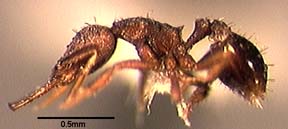Strumigenys gundlachi (Roger 1862)
Dacetonini, Formicidae, Hymenoptera, Insecta, Arthropoda, Animalia
John T. Longino, The Evergreen State College, Olympia WA 98505
USA.
longinoj@evergreen.edu
21 April 1997

Specimen: Costa Rica, Prov. Alajuela: Rio Penas Blancas, 800m (J. Longino 2529-s). INBIOCRI001281414. Image by J. Longino. 
Constrasting presence of spongiform appendages between gundlachi and eggersi. Drawing based on Brown (1960).
Identification
Apical fork of mandible small, with two tiny intercalary denticles; mandibles straight, with weakly convex inner borders, each bearing 4-9 minute denticles on distal 1/2; spongiform appendages present on ventral surface of petiole and postpetiole (in constrast to S. eggersi); first gastral tergum smooth and shining (in constrast to S. eggersi).
Head length 0.40-0.49mm, mandible length 0.24-0.32, CI 79-86, MI 59-66 (n=36 workers from 20 localities; Brown 1962).
Similar species: eggersi, subedentata, trieces.
Range
Mainland tropical America from southern Mexico south to Venezuela, and on many Caribbean islands. Costa Rica: Atlantic and southern Pacific lowlands, Cordillera de Tilaran, Cordillera de Guanacaste.
Natural History
Brown and Wilson (1959) summarize the genus as follows:
"Widespread in tropics and warm temperate areas. Primarily forest-dwelling; some species occur in grassland and arid scrub. ... Nests mostly in soil and rotting wood; a few species live in arboreal plant cavities in tropical rain forest. Foraging hypogaeic to epigaeic-arboreal. Food: most species are collembolan feeders; a few are polyphagous predators or occasionally feed on sugary substances..."
|

Specimen: Costa Rica, Prov. Alajuela: Rio Penas Blancas, 800m (J. Longino 2529-s). INBIOCRI001281414. Image by J. Longino. 
Face view of worker and, magnified at lower right, anterior view of apical fork of mandible. Drawing based on Brown (1960, 1962). |
For gundlachi, Brown (1960) reported
"E. O. Wilson (unpubl. notes) kept a colony of gundlachi for over a month in Cuba, during which time it captured and consumed entomobryoid and sminthurid collembolans, but ignored poduroids, a small cricket nymph, various mites and minute millipeds. Hunting is usually of the relatively immobile ambush type, which is to say that the ants approach the prey and, when close enough to detect its position, freeze with mandibles held open toward it... However, sometimes workers approach the prey and strike quickly and directly, without waiting. If prey is struck and continues to struggle, it is lifted off the ground and stung..."
"McCluskey and I found this species in nearly every berlesate of upper soil and leaf litter that we examined on Barro Colorado Island; it is evidently there the most common dacetine species and one of the more frequent ant species of the forest floor. Wilson found gundlachi to be somewhat less abundant in Veracruz. Although it is abundant in tropical rain forest, it also lives in second-growth forest, thickets, and cacao plantations."
In Costa Rica gundlachi is very common in moist to wet lowland forest. It also occurs in the very wet mid-elevation forest of the Atlantic slope of the Tilaran and Guanacaste Cordilleras, but has not been observed in similar habitats in the Cordillera Central (in spite of many Winkler samples from mid-elevation sites in Braulio Carrillo National Park). It occurs in the moist evergreen forest band on the Pacific slopes of the Tilaran and Guanacaste Cordilleras, but does not occur in nearby cloud forest.
Selected Records
Winkler samples from La Selva, Braulio Carrillo National Park at 300m, Rara Avis, Hitoy Cerere, Penas Blancas Valley, Guanacaste Conservation Area (Pitilla, Cacao), road to Monteverde at 900m (islolated patch of evergreen forest in ravine), Carara, Manuel Antonio National Park, Osa Peninsula (Rancho Quemado), Corcovado National Park (Sirena), 19km S Ciudad Neily.
Literature Cited
Brown, W. L., Jr. 1960 (1959). The neotropical species of the ant genus Strumigenys Fr. Smith: Group of gundlachi (Roger). Psyche 66:37-52.
Brown, W. L., Jr. 1962. The neotropical species of the ant genus Strumigenys Fr. Smith: Synopsis and keys to the species. Psyche 69:238-267.
Brown, W. L., Jr., Wilson, E. O. 1959. The evolution of the dacetine ants. Quarterly Review of Biology 34:278-294.
 Go back to top
Go back to top



